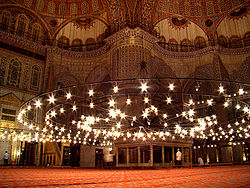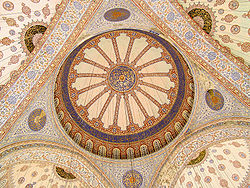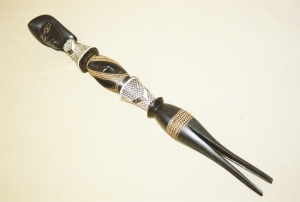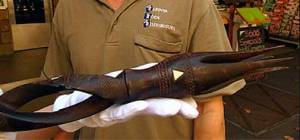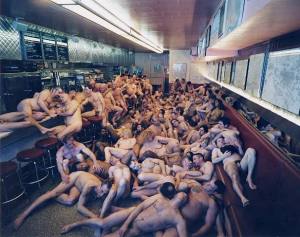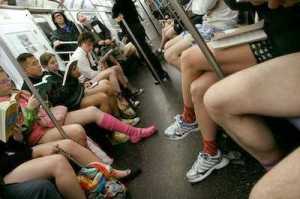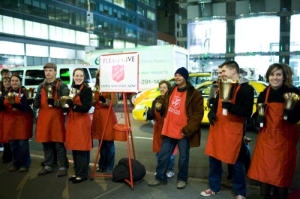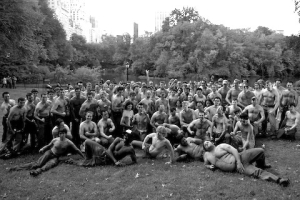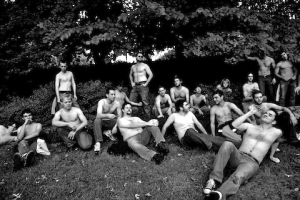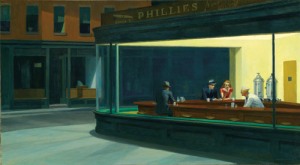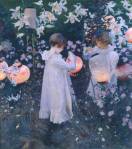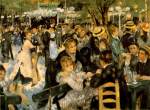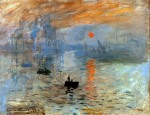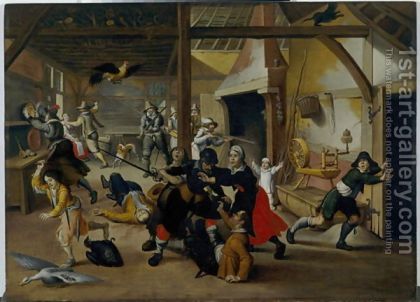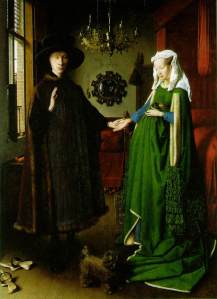The Blue Mosque
April 27, 2010
I have chosen the Sultan Ahmed Mosque or the “Blue Mosque” as my non western art. Archtiecture is the most elaborate expression of art, and when involved with religion can be the most significant.
The Blue mosque was built between 1609 and 1616 by Sultan Ahmed I after losing a major war with Persia. He decided to build the temple to regain favor with god. He chose architect Sedefhar Mehmet Aga to build the mosque. The Blue Mosque was built over the site of the Imperial Palace of Constantinople. The Palace was the home of the Eastren Roman Emperors and was the Center of the western world for many years.
This mosque got its nickname from the blue tiles used in the interior. The mosque has many of the archtypical tile mosaics of Islamic art and the minarets that are so important to Islamic prayer.
This is an interior photo of the main prayer room.
This is the same prayer room, with the elaborate chandeleir lighting the room.
This is the ceiling view of the great dome. Note the traditional Islamic mosiac and the blue tiles.
ICULANIBOKOLA-Canibal Forks
April 27, 2010
ICULANIBOKOLA-Fijian Canibal forks
I chose Fijian cannibal forks as my ‘non-western’ visual art. These pieces are as far removed from modern western behavior as possible. While we may consider it a touch gruesome, forks were pieces of great art and religious value for Fijian people.
The history of these forks dates back to a prehistoric group-the Lapita-that eventually founded the majority of pacific peoples. Fiji was settled by early Lapita, then inundated with Malay peoples and finally Polynesian peoples. These groups all have recent (well, recent is relative) history of cannibalism and is believed that the ancestral peoples of the pacific brought cannibalism with them as a cultural trait. This is of course contested. To narrow down my narrative, Fijians partook in cannibalism until the very late 1800’s on a wide spread scale, and in smaller isolated incidents until the 1920’s. American expeditions recorded active cannibalism on a tribal scale in the 1890’s. It must be noted that many accounts were biased and falsified, but many accounts were very diligently recorded by relatively open people. Canibalism was also recorded in photography and these are on display in Suva, Fiji
Cannibalism was a religious ritual in which ones enemy was disgraced by being consumed, and his energy/power was transferred to the consumer. If a victorious tribe was feeling rather hostile they would cook a victim and then fed him to the pigs or let him waste. This was an even worse insult.
These forks arose for several reasons. First is a cultural taboo that prohibits chiefs and priests from touching food with their hands. Common Fijians generally did not use utensils until Europeanization. One of the most important ceremonies a chieftain participated in was the devouring of their or the tribes enemy. Combining the significance of the event and the inability to use their hands the chiefs needed a way to participate-hence the development of the cannibal fork. Forks became a way to show power and influence. The fancier more elaborate the fork, the higher status the owner had. Combining social status, religion and warfare made production of these forks a royal undertaking. Elaborate carvings from unique materials including human bone became the sole purpose of dedicated craftsmen.
To make an analogy these forks were the equivalent of crowns, or thrones or in today’s world fancy sports cars and private jets.
However gruesome we might perceive these items (considering how many are made and sold a year as tourist nick-nacks we can’t be that squeamish) they are very beautiful and have amazing detail that when compared to the production technologies of the time and place are outright marvelous. Many of the European sculptures we have covered are not in this level of detail. These forks show that humans will make art in whatever context and in anyplace.
http://ngm.nationalgeographic.com/ngm/flashback/0303/index.html
http://query.nytimes.com/mem/archive-free/pdf?_r=1&res=950DE5DF143AE533A25751C1A9619C94609ED7CF
People as Art-Flash Mobs and Expression
April 15, 2010
This exhibit is about the ability of people themselves to be art. Originating and heavily influenced by performance art, Flash Mobs use groups of people to express an idea, an agenda or just for the artistic merit. Flash mobs can have a wide range of styles, impact and outcomes.
The term flash mob originated with author Larry Niven. Like most Sci-fi writers, Niven has had several scientific theories and concepts named after him or been responsible for their conception. (Larry Niven had Niven Rings and Niven Worlds, Arthur C. Clark invented satellites and so forth). It is not to often that a Science fiction writer titles an art movement.
“In 1973, the story “Flash Crowd” by Larry Niven described a concept similar to flash mobs.[14] With the invention of popular and very inexpensive teleportation, an argument at a shopping mall – which happens to be covered by a news crew – quickly swells into a riot. In the story, broadcast coverage attracts the attention of other people, who use the widely available technology of the teleportation booth to swarm first that event – thus intensifying the riot – and then other events as they happen. Commenting on the social impact of such mobs, one character (articulating the police view) says, “We call them flash crowds, and we watch for them.” In related short stories, they are named as a prime location for illegal activities (such as pick pocketing and looting) to take place.” http://en.wikipedia.org/wiki/Flash_mob
Flash Mobs derive their name and definition from the technology used to establish, assemble and control them. Cell phones, e-mail, twitter and IM programs are used to prevent the target from discovering the plan, or more maliciously prevent the authorities from intervening.
The most popular and well known Flash Artist is Spencer Tunick. Spencer Tunick has very little biographical data available at this point. He was born Jan.1, 1967. He is an American and lives in Brooklyn. His work started off small and had strong early influences from Guerilla art. Tunick began photographing singular nudes in urban London and has become famous for photographing large numbers of nudes in public spaces. Tunick eventually expanded his scope as his fame grew, culminating in May 6, 2007 in Mexico city where he had 18,000 nudes model.
Tunick recruits from his website and requires participants to submit their skin tone so Tunick can control the shades and hues of his piece. Each participant receives a signed print afterwards. Using the Internet ties Tunick in with Flash Mobbing. Many of Tunick’s shoots have been prohibited and he has had to resort to the more clandestine and ephemeral organization of flash mobbing.
Tunick initially began photographing for his own artistic statement, but has recently used his talent and fame to bring attention to different social issues.
The first of Tunick’s social statements was done at the request of Poz magazine in 2004 he photographed 85 HIV-positive men and women posing nude in Manhattan’s Florent restaurant to call attention to World AIDS Day.
Tunick also collaborated with Greenpeace in 2007 for a photo shoot in the Alps at Aletsch Glacier in Switzerland. This was to bring attention to the massive melt off that Aletsch has seen over just the previous year (328 linear feet). http://www.slate.com/id/2182124/
One of the eminent Flash Mob performance art groups in the US is Improve Everywhere. http://improveverywhere.com/. Created in 2001 by Charlie Todd, Improve everywhere is a large collection of sometimes collaborating artists and an even larger collection of “art” or participants. Improve Everywhere heavily uses mainstream technology to organize their activities. The Improve Everywhere is dependent on their website to spread news of previous “missions” and recruit for new events.
One event is the Underwear Flash Mob. This was an organized group of up to 900 people that rode the New York Subway (and Boston, Washington DC, Portland, San Francisco, Chicago, Toronto, Baltimore and Salt Lake City as well)
This was done for the 7th Annual No Pants Subway Ride. While this has become somewhat of an institution at this point, it still was an original Flash Mob and uses the same operating methods.
My Favorite Improve Everywhere “Mission” was the “Guerilla Handbell Stikeforce”. Improve Everywhere recruited Cory Davis, the bell choir conductor for Christ Church United Methodist in Manhattan for their mission. Improve Everywhere showed up to a location where a Salvation Army Christmas Bell ringer was working and “assisted him” in spreading Christmas cheer. The Church Handbell choir preformed with/for the Bell ringer.
“As we hoped, there was a bell ringer stationed in front of the entrance to the store. The Salvation Army often uses volunteers for this job, but in New York almost all of the bell ringers are paid, seasonal employees. Our goal with this mission wasn’t to make any sort of statement about the Salvation Army (an organization that I’m sure does lots of great charitable work, but also is not without controversy), but to create an awesome moment for one bell ringer and the random New Yorkers and tourists who happened to be in the right place at the right time.”
– Improve Everywhere
http://improveverywhere.com/2009/12/14/guerrilla-handbell-strikeforce/
Another Improve Everywhere mission was “No Shirts”. In October 2007 Improve everywhere influenced by the half naked models that worked at a local Abercrombie and Fitch recruited 111 men of all sizes and shapes to Flash Mob on the store. The men posed for photos before the Flash Mobbing and then entered the store to “shop” and pose for other customers-similar to what the paid models job was. The posed photos are in parody of Abercrombie and Fitch catalogs and advertizing.
http://improveverywhere.com/2007/10/17/no-shirts/
Flash Mobbing while a tool for artistic expression and performance theatre can also be a tool for revolution, rioting and destruction. In 2005 civil unrest in France, around Paris was fueled and controlled by operators using Flash Mobbing. Flash Mob operators used scouts to determine the location of riot police and directed the rioters around law enforcement to unprotected areas. When police would close in on the rioters they would be given advanced notice and disappear, to regroup at a different site later. 274 towns were subject to the traveling riot who moved in and out of communities unrelated to the original cause. (The deaths of two Muslim boys in a Muslim housing project). 8973 vehicles were damaged/set ablaze and 200 million Euros in damage was done through arson and vandalism to buildings. 2888 people were arrested and 126 Police and Firefighters were injured. http://en.wikipedia.org/wiki/2005_civil_unrest_in_France
While the underlying tensions that led tens of thousands to riot cannot be diminished or put aside, the use of Flash Mobbing allowed the violence to go on for weeks and spread out of control.
Nighthawk
April 10, 2010
I chose “Nighthawk” by Edward Hopper. I have always liked this painting and chose it even though I can only minimally relate it to the themes of the assignment. Edward Hopper does not quite fit into the general period of the Avant Garde and Abstraction, but what I call the counter-abstract movement and is closer to American regionalism.
Edward Hopper had made comments on this painting as being themed about predation (which fits the title) but this work is often been viewed with loneliness. http://en.wikipedia.org/wiki/Edward_Hopper I do not view the solitary man at the counter as threatening, nor the individual whose perspective the painting is from. Maybe there should be some eerie background music. I worked nights for several years and this painting reminds me of the silence and emptiness of a city at night. The painting is from 1942 so has closer ties to the end of the depression and the start of WWII than probably any other influences. This painting is clearly in a place before the war. I make this statement because there would have been two distinctions of mid war America. One is the droves of night shift factory workers. War manufacturing never shuts down and factories were kept open 24/7 by War’s end to keep up with demand. Therefore there would be tons of services such as diners for war workers. Two, is the lack of blackout curtains. Even the Plains States had blackout and light regulations. I think the artist himself is somewhat influenced by the depression. Hopper painted calm, easy going American and apple pie themes. I think these themes were popular because people longed for the pre-crash times when they could go to a diner. I think people found comfort in images that matched their perception of better times.
Impressionism
March 25, 2010
I would have to say that overall I like impressionism. I was a little leery at first, but the art style grew on me. I found some of the subject matter to be a bit trite. I much prefer the subject matter of the neoclassical or the realists. However neo classicalism and realism lack feeling. To make my point I chose Winslow Homer’s “Prisoners from the Front”.
I prefer the detail and intense accuracy of Homer’s work, but after viewing the impressionists, “Prisoners from the Front” seemed hollow. The soldiers while well defined and perfect, are just standing there. They do not seem to belong to the background, or perhaps the background does not belong to them. I feel as if they were cut and pasted into the work. To contrast Homer’s painting I chose John Singer Sargent’s “Carnation, Lily, Lily, Rose.
Sargent’s painting seems to me to blend the background, foreground and subject into one unifying entity. The paper lanterns seem to be part of the subject as well as the action verb. The two girls seem to be surrounded in what I would call light of Faery. I do see strong correlations with the people of the Side and the orange lanterns decoration style of the garden. . This is clear contrast to the perfect soldiers of Homer.
Dance at the Moulin de la Galette by Pierre-Auguste Renoir does not seem to fit the style mold of impressionism as clearly as other works even by Renoir. The party guests still seem to have a lot of the detail and defined characteristics of earlier art styles. The flow and continuation of the party is what earns the painting its spot in impressionism. All the guests seem to be part of the same continuity.
Not all impressionistic art was to my liking though. Particularly Claude Monet’s “Impression Sunrise”.
In my opinion it is just a blurring of grey. It is subject less (I do not think that mist is a true subject). As a first step in a new style the painting has to be given some grace. To me it seemed as if the focus was on blending the background with the foreground. Not with incorporating any subject into the painting. However this same type of blending is what I appreciate in other works.
Classical Music
March 15, 2010
I choose Beethoven’s Symphony Number 5 in C minor. http://www.youtube.com/watch?v=evr7pgSsVoo&feature=related
I thought my choice may have been a little trite, as this is one of the most overplayed songs EVER. However I realized that I had never listened to more than the first min of the first movement. (However long a movie scene or commercial is). It was basically a new song for me. It was very apparent when the song changed from movement to movement. These were very distinct sections, and were in my opinion like different songs on the same soundtrack.
One other thing that I noticed is a lot of music I thought of as classical, is really from the romantic period. After listening to some of these latter pieces, the presence of the four movements is very distinct in a classical work.
Baroque Blog
February 23, 2010
SOILDERS PLUNDERING A FARM DURING THE THIRTY YEARS WAR
Sebastian Vrancx 1620
I chose this painting because it clearly depicts events from the Baroque time. The Baroque period was heavily punctuated by the Thirty Years war. The carnage and genocide influenced every single person in Europe artists included. If your country was not actively fighting at the moment, you were paying exorbitant taxes so your ruler could give monetary aid to countries that were fighting.
The low countries where Vrancx was from were heavily involved in the intrigue and combat of the time period and it is no surprise that Vrancx main subject was warfare. Vrancx worked with Ruben and Brueghal the Elder as contemporary and collaborators.
Vrancx does not fight into either of the Poussinistes or Rubenistes school of art. Vrancx drafted most of his work which heavily depends on line (Poussinistes style) but he also occasionally focused on color which does not exclude him from Rubenistes styling. Many of Vrancx paintings were rather drab. Four landscapes for four seasons is an example (http://www.artcyclopedia.com/artists/vrancx_bastiaen.html). I believe that Vrancx depended more on line then color.
The Subject matter is fitting for the time period and is why I choose the painting. I feel this painting represents the schizophrenic culture of Europe. Soldiers stood in orderly lines and fought with very elaborate codes of conduct (rules of chivalry). It was unfitting and an utter disgrace for a military unit to not perform to the moral standard during battle. However for the remaining time, there were no rules and no morality that applied. The man facing you in battle with full formality and dignity may have just raped your wife and burnt your home. Soldiers were expected to loot and plunder for food. Military organization had been forgotten and armies were formed and deployed without food, shelter or extra clothing. It was cheaper to take from the locals and far easier then shipping food across the continent. http://en.wikipedia.org/wiki/Thirty_Years’_War Entire populations were eradicated Wurttemberg lost 75% of its estimated 1 million inhabitants. The German region lost (by lost I mean eradicated and razed to the ground) 2000 castles, 18,000 villages and 1500 towns to just the Swedes.
This painting to me has the same symbolism that a painting of the holocaust or the killing grounds of Kosovo would. The military uniforms are different, but the events are all too similar.
Northern renaissance
February 13, 2010
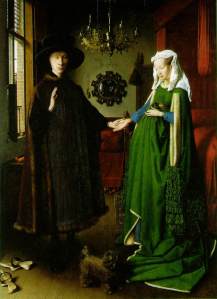 I chose the painting Arnolfini Portrait by Van Eyck because of the mystery and controversy surrounding it. Van Eyck was born somewhere in Flanders and the exact year and location are unknown. During his lifetime the low countries including Flanders were in fiefdom to the Duchy of Burgundy. The Duke of Burgundy Phillip the good was Van Eyck’s patron for the majority of Van Eyck’s career. The Duchy of Burgundy surpassed in wealth, maritime and martial power, trade and wealth most of Europe. This opulence allowed patronage and support of the arts similar to the much wealthier Italian states. While not many of Van Eyck’s works survive, the Arnolfini Portrait may be the most controversial. The primary controversy centres around who is depicted by the painting. Two Arnolfini family members are thought to be the subject of the painting. Giovanni di Nicolao Arnolfini is widely accepted to be the subject. However if he is the subject, his wife was dead long before 1434 the year that Van Eyck inscribed above the mirror. So that leaves three options. First is that Giovanni is not the Arnolfini depicted. Second this is a funerary/memorial portrait commissioned by a lovelorn husband. Third is that it is a wedding portrait of Giovanni’s second wife. Historians have narrowed down the Arnolfini based on ducal court records, birth and death records, and trade records. I will side with these historians because they have looked at numerous records that I have no access to, and their findings have been disputed and critiqued by other historians. The second option is that it is a funerary painting. However the wife was not buried in 1434, she would not have been present for sittings for some time before the written date. Either the painting took many years, or Van Eyck had the worlds greatest memory. The idea that it is a forlorn husband is a very cultural-centric idea. During the 1400’s people died like insects, marriages were arranged even in the non royal merchant class that Arnolfini belonged to. Attachments were not quite the same as today. Yes, Arnolfini may have deeply loved his wife, but romantic notions are often created to gloss over uncouth realities. This is why I support the third option-marriage portrait to another woman. Clear defined marriage was critical to trade and wealth of merchant and noble families alike. Arnolfini would need to prove he was married to the women to access her dowry and family bank accounts. Any offspring would need to prove that they were legitimate to inherit the family wealth. This is even more critical in a second marriage. The only guarantees for the wealthy were that plague would decimate your lands and your children and family would destroy each other after your death. Flemish business men were among the most ruthless in European history. The determination of a legitimate Arnolfini heir had implications that would affect every single day that Arnolfini did business. This painting if used as a marriage portrait would prove its value daily. One must look at the possibilities with the same pragmatism a Flemish merchant would use. Unlike Popes and Kings, a businessman would not invest in the expense of a painting if he would not get a return. (AlthI chose the painting Arnolfini Portrait by Van Eyck because of the mystery and controversy surrounding it. Van Eyck was born somewhere in Flanders and the exact year and location are unknown. During his lifetime the low countries including Flanders were in fiefdom to the Duchy of Burgundy. The Duke of Burgundy Phillip the good was Van Eyck’s patron for the majority of Van Eyck’s career. The Duchy of Burgundy surpassed in wealth, maritime and martial power, trade and wealth most of Europe. This opulence allowed patronage and support of the arts similar to the much wealthier Italian states. While not many of Van Eyck’s works survive, the Arnolfini Portrait may be the most controversial. The primary controversy centres around who is depicted by the painting. Two Arnolfini family members are thought to be the subject of the painting. Giovanni di Nicolao Arnolfini is widely accepted to be the subject. However if he is the subject, his wife was dead long before 1434 the year that Van Eyck inscribed above the mirror. So that leaves three options. First is that Giovanni is not the Arnolfini depicted. Second this is a funerary/memorial portrait commissioned by a lovelorn husband. Third is that it is a wedding portrait of Giovanni’s second wife. Historians have narrowed down the Arnolfini based on ducal court records, birth and death records, and trade records. I will side with these historians because they have looked at numerous records that I have no access to, and their findings have been disputed and critiqued by other historians. The second option is that it is a funerary painting. However the wife was not buried in 1434, she would not have been present for sittings for some time before the written date. Either the painting took many years, or Van Eyck had the worlds greatest memory. The idea that it is a forlorn husband is a very cultural-centric idea. During the 1400’s people died like insects, marriages were arranged even in the non royal merchant class that Arnolfini belonged to. Attachments were not quite the same as today. Yes, Arnolfini may have deeply loved his wife, but romantic notions are often created to gloss over uncouth realities. This is why I support the third option-marriage portrait to another woman. Clear defined marriage was critical to trade and wealth of merchant and noble families alike. Arnolfini would need to prove he was married to the women to access her dowry and family bank accounts. Any offspring would need to prove that they were legitimate to inherit the family wealth. This is even more critical in a second marriage. The only guarantees for the wealthy were that plague would decimate your lands and your children and family would destroy each other after your death. Flemish business men were among the most ruthless in European history. The determination of a legitimate Arnolfini heir had implications that would affect every single day that Arnolfini did business. This painting if used as a marriage portrait would prove its value daily. One must look at the possibilities with the same pragmatism a Flemish merchant would use. Unlike Popes and Kings, a businessman would not invest in the expense of a painting if he would not get a return. (Although being discussed almost 600 years later could be considered a substantial return) http://www.nationalgallery.org.uk/paintings/jan-van-eyck-the-arnolfini-portrait http://en.wikipedia.org/wiki/Jan_van_Eyck ough being discussed almost 600 years later could be considered a substantial return) http://www.nationalgallery.org.uk/paintings/jan-van-eyck-the-arnolfini-portrait http://en.wikipedia.org/wiki/Jan_van_Eyck
I chose the painting Arnolfini Portrait by Van Eyck because of the mystery and controversy surrounding it. Van Eyck was born somewhere in Flanders and the exact year and location are unknown. During his lifetime the low countries including Flanders were in fiefdom to the Duchy of Burgundy. The Duke of Burgundy Phillip the good was Van Eyck’s patron for the majority of Van Eyck’s career. The Duchy of Burgundy surpassed in wealth, maritime and martial power, trade and wealth most of Europe. This opulence allowed patronage and support of the arts similar to the much wealthier Italian states. While not many of Van Eyck’s works survive, the Arnolfini Portrait may be the most controversial. The primary controversy centres around who is depicted by the painting. Two Arnolfini family members are thought to be the subject of the painting. Giovanni di Nicolao Arnolfini is widely accepted to be the subject. However if he is the subject, his wife was dead long before 1434 the year that Van Eyck inscribed above the mirror. So that leaves three options. First is that Giovanni is not the Arnolfini depicted. Second this is a funerary/memorial portrait commissioned by a lovelorn husband. Third is that it is a wedding portrait of Giovanni’s second wife. Historians have narrowed down the Arnolfini based on ducal court records, birth and death records, and trade records. I will side with these historians because they have looked at numerous records that I have no access to, and their findings have been disputed and critiqued by other historians. The second option is that it is a funerary painting. However the wife was not buried in 1434, she would not have been present for sittings for some time before the written date. Either the painting took many years, or Van Eyck had the worlds greatest memory. The idea that it is a forlorn husband is a very cultural-centric idea. During the 1400’s people died like insects, marriages were arranged even in the non royal merchant class that Arnolfini belonged to. Attachments were not quite the same as today. Yes, Arnolfini may have deeply loved his wife, but romantic notions are often created to gloss over uncouth realities. This is why I support the third option-marriage portrait to another woman. Clear defined marriage was critical to trade and wealth of merchant and noble families alike. Arnolfini would need to prove he was married to the women to access her dowry and family bank accounts. Any offspring would need to prove that they were legitimate to inherit the family wealth. This is even more critical in a second marriage. The only guarantees for the wealthy were that plague would decimate your lands and your children and family would destroy each other after your death. Flemish business men were among the most ruthless in European history. The determination of a legitimate Arnolfini heir had implications that would affect every single day that Arnolfini did business. This painting if used as a marriage portrait would prove its value daily. One must look at the possibilities with the same pragmatism a Flemish merchant would use. Unlike Popes and Kings, a businessman would not invest in the expense of a painting if he would not get a return. (AlthI chose the painting Arnolfini Portrait by Van Eyck because of the mystery and controversy surrounding it. Van Eyck was born somewhere in Flanders and the exact year and location are unknown. During his lifetime the low countries including Flanders were in fiefdom to the Duchy of Burgundy. The Duke of Burgundy Phillip the good was Van Eyck’s patron for the majority of Van Eyck’s career. The Duchy of Burgundy surpassed in wealth, maritime and martial power, trade and wealth most of Europe. This opulence allowed patronage and support of the arts similar to the much wealthier Italian states. While not many of Van Eyck’s works survive, the Arnolfini Portrait may be the most controversial. The primary controversy centres around who is depicted by the painting. Two Arnolfini family members are thought to be the subject of the painting. Giovanni di Nicolao Arnolfini is widely accepted to be the subject. However if he is the subject, his wife was dead long before 1434 the year that Van Eyck inscribed above the mirror. So that leaves three options. First is that Giovanni is not the Arnolfini depicted. Second this is a funerary/memorial portrait commissioned by a lovelorn husband. Third is that it is a wedding portrait of Giovanni’s second wife. Historians have narrowed down the Arnolfini based on ducal court records, birth and death records, and trade records. I will side with these historians because they have looked at numerous records that I have no access to, and their findings have been disputed and critiqued by other historians. The second option is that it is a funerary painting. However the wife was not buried in 1434, she would not have been present for sittings for some time before the written date. Either the painting took many years, or Van Eyck had the worlds greatest memory. The idea that it is a forlorn husband is a very cultural-centric idea. During the 1400’s people died like insects, marriages were arranged even in the non royal merchant class that Arnolfini belonged to. Attachments were not quite the same as today. Yes, Arnolfini may have deeply loved his wife, but romantic notions are often created to gloss over uncouth realities. This is why I support the third option-marriage portrait to another woman. Clear defined marriage was critical to trade and wealth of merchant and noble families alike. Arnolfini would need to prove he was married to the women to access her dowry and family bank accounts. Any offspring would need to prove that they were legitimate to inherit the family wealth. This is even more critical in a second marriage. The only guarantees for the wealthy were that plague would decimate your lands and your children and family would destroy each other after your death. Flemish business men were among the most ruthless in European history. The determination of a legitimate Arnolfini heir had implications that would affect every single day that Arnolfini did business. This painting if used as a marriage portrait would prove its value daily. One must look at the possibilities with the same pragmatism a Flemish merchant would use. Unlike Popes and Kings, a businessman would not invest in the expense of a painting if he would not get a return. (Although being discussed almost 600 years later could be considered a substantial return) http://www.nationalgallery.org.uk/paintings/jan-van-eyck-the-arnolfini-portrait http://en.wikipedia.org/wiki/Jan_van_Eyck ough being discussed almost 600 years later could be considered a substantial return) http://www.nationalgallery.org.uk/paintings/jan-van-eyck-the-arnolfini-portrait http://en.wikipedia.org/wiki/Jan_van_Eyck
Test
January 25, 2010
This is a test posting


